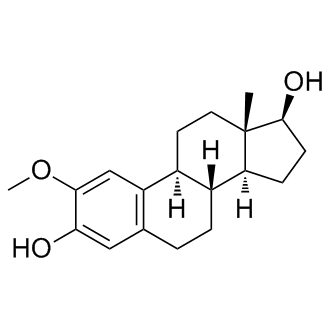| In Vitro: |
2-Methoxyestradiol (5-100 μM) inhibits assembly of purified tubulin in a concentration-dependent manner, with maximal inhibition (60%) at 200 μM 2-Methoxyestradiol (2ME2). However, with microtubule-associated protein-containing microtubules, significantly higher 2-Methoxyestradiol concentrations are required to depolymerize microtubules, and polymer mass is reduced by only 13% at 500 μM 2-Methoxyestradiol. 4 μM 2-Methoxyestradiol reduces the mean growth rate by 17% and dynamicity by 27%. In living interphase MCF7 cells at the IC50 for mitotic arrest (1.2 μM), 2-Methoxyestradiol significantly suppresses the mean microtubule growth rate, duration and length, and the overall dynamicity, consistent with its effects in vitro, and without any observable depolymerization of microtubules. 2-Methoxyestradiol induces G2-M arrest and apoptosis in many actively dividing cell types while sparing quiescent cells. 2-Methoxyestradiol binds to tubulin at or near the colchicine site, it inhibits microtubule assembly, and high concentrations have been shown to depolymerize microtubules in cells. 2-Methoxyestradiol induces G2-M arrest and apoptosis in many actively dividing also blocks mitosis and inhibits endothelial cell migration[1]. 2-Methoxyestradiol (2-ME) decreases the HIF-1α and HIF-2α nuclear staining in cells cultured under hypoxia. The HIF-1α and HIF-2α mRNA levels are significantly lower when cells are exposed to 2-Methoxyestradiol under normoxia and hypoxia. 2-Methoxyestradiol is an anti-angiogenic, anti-proliferative and pro-apoptotic agent that suppresses HIF-1α protein levels and its transcriptional activity. A significant decrease in the growth rate is found in the 10 µM 2-Methoxyestradiol-treated A549 cells in comparison with the DMSO-treated cells (66.2±7.2 and 101.2±2.3%, respectively; p=0.04) at 96 h. 2-Methoxyestradiol at a concentration of 10 µM is used for the apoptosis and HIF-1α and HIF-2α expression assays, due to the significance found for this concentration when cells are incubated under normoxic conditions at 72 h. A significant increase in apoptosis is observed in cells treated with 10 µM 2-Methoxyestradiol in a normoxic condition in comparison with cells under lower O2 concentration (5.8±0.2%; p=0.003)[2]. |






















